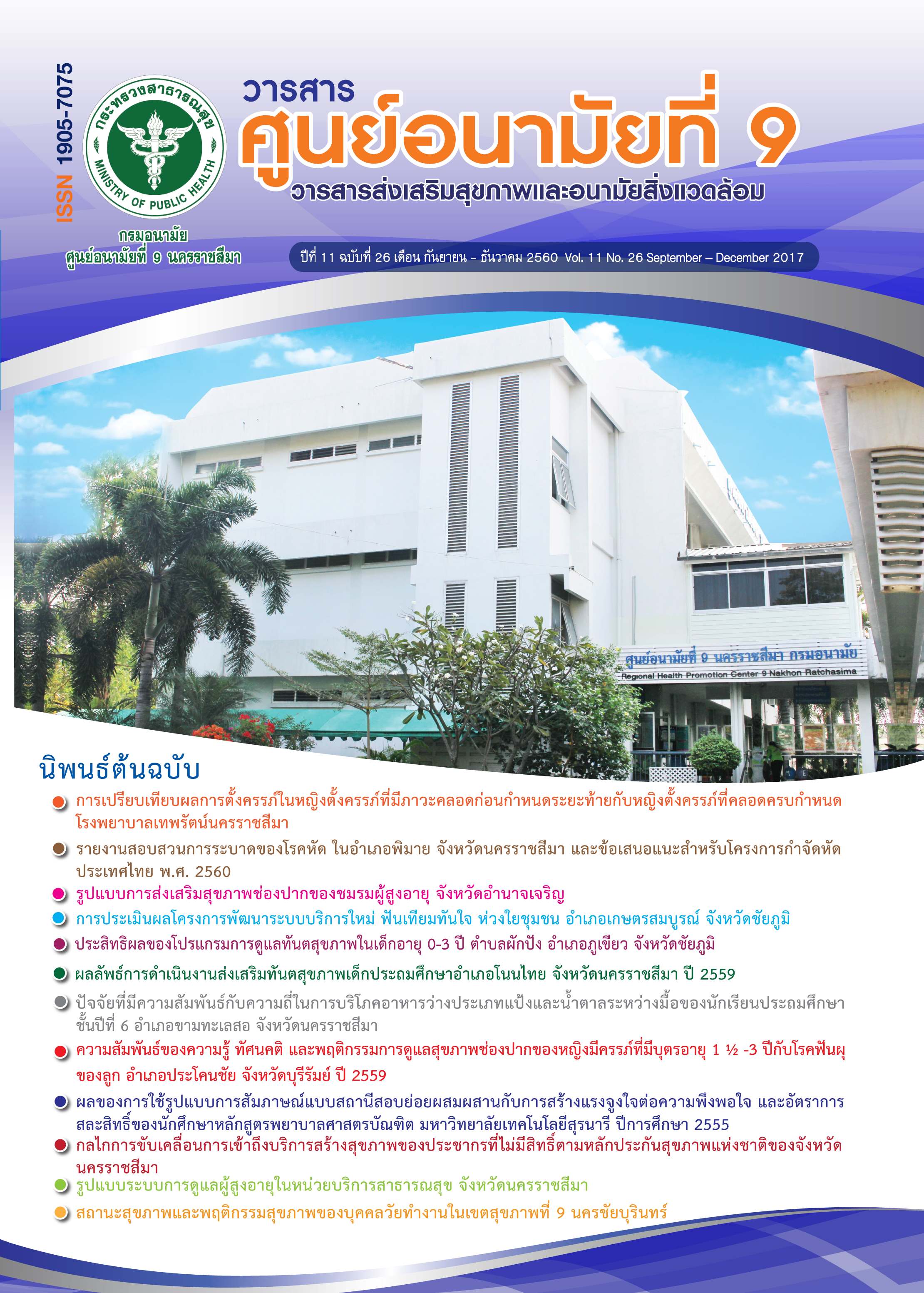ผลของการใช้รูปแบบการสัมภาษณ์แบบสถานีสอบย่อยผสมผสานกับการสร้างแรงจูงใจต่อความพึงพอใจและอัตราการสละสิทธิ์ของนักศึกษาหลักสูตรพยาบาลศาสตรบัณฑิต มหาวิทยาลัยเทคโนโลยีสุรนารี ปีการศึกษา 2555
คำสำคัญ:
การสัมภาษณ์แบบสถานีสอบย่อย, การสร้างแรงจูงใจ, นักศึกษาพยาบาล, อัตราการสละสิทธิ์บทคัดย่อ
วัตถุประสงค์ การวิจัยนี้เป็นวิจัยเชิงพรรณนา (Descriptive research) วัตถุประสงค์เพื่อ 1) ศึกษาความพึงพอใจของคณะกรรมการและนักเรียนต่อการใช้รูปแบบการสอบสัมภาษณ์แบบสถานีสอบย่อย (Multiple Mini Interview: MMI) ผสมผสานกับการสร้างแรงจูงใจในการคัดเลือกบุคคลเข้าศึกษาหลักสูตรพยาบาลศาสตรบัณฑิต ปีการศึกษา 2555 2) ความพึงพอใจของผู้ปกครองต่อกิจกรรมการสร้างแรงจูงใจในการคัดเลือกบุคคลเข้าศึกษาหลักสูตรพยาบาลศาสตรบัณฑิต ปีการศึกษา 2555 และ 3) ศึกษาอัตราการสละสิทธิ์และสาเหตุการสละสิทธิ์ของนักศึกษาหลักสูตรพยาบาลศาสตรบัณฑิต มหาวิทยาลัยเทคโนโลยีสุรนารี ปีการศึกษา 2555 ระเบียบวิธีวิจัย กลุ่มตัวอย่างประกอบด้วยคณะกรรมการสอบสัมภาษณ์ นักเรียนและผู้ปกครองที่เข้ารับการสอบสัมภาษณ์เพื่อเข้าศึกษาหลักสูตรพยาบาลศาสตรบัณฑิต ประจำปีการศึกษา 2555 จำนวน 151 คน เครื่องมือที่ใช้ในการวิจัยประกอบด้วย 1) กิจกรรมการสัมภาษณ์แบบ MMI 2) กิจกรรมการสร้างแรงจูงใจแก่ผู้ปกครองและผู้มีสิทธิ์สอบสัมภาษณ์ 3) แบบสอบถามความพึงพอใจ เป็นมาตราส่วนประมาณค่า (1 = พึงพอใจน้อยที่สุด , 5 = พึงพอใจมากที่สุด) ของผู้รับการสัมภาษณ์ต่อรูปแบบการสัมภาษณ์แบบ MMI 4) แบบสอบถามความพึงพอใจของกรรมการสัมภาษณ์ต่อรูปแบบการสัมภาษณ์แบบ MMI และ 5) แบบสอบถามความพึงพอใจของผู้ปกครองต่อกิจกรรมการสร้างแรงจูงใจ การวิเคราะห์ข้อมูล วิเคราะห์ข้อมูลโดยใช้สถิติพรรณนา ความถี่ ร้อยละ ค่าเฉลี่ย และส่วนเบี่ยงเบนมาตรฐาน ผลการวิจัย พบว่านักเรียนผู้เข้ารับการสอบสัมภาษณ์มีความพึงพอใจต่อการสอบสัมภาษณ์แบบ MMI ในระดับมากที่สุด (Mean=4.76, S.D.=0.48) ผู้ปกครองนักเรียนที่เข้ารับการสอบสัมภาษณ์มีความพึงพอใจต่อกิจกรรมการสร้างแรงจูงใจ ในระดับมากที่สุด (Mean=4.86, S.D.=0.39) คณะกรรมการผู้สอบสัมภาษณ์มีความพึงพอใจต่อการสอบสัมภาษณ์แบบ MMI ในระดับมากที่สุด (Mean=4.74, S.D.=0.45) ข้อมูล ณ วันเปิดภาคการศึกษา 2555 พบว่ามีผู้สละสิทธิ์ 18 คน คิดเป็นร้อยละ 37.50 จากผู้ที่มีสิทธิ์เข้าศึกษาทั้งหมด 48 คนลดลงจากปีการศึกษา 2554 ถึงร้อยละ 16.67 (ปีการศึกษา 2554 มีผู้สละสิทธิ์จำนวน 26 คน คิดเป็นร้อยละ 54.17 จากผู้ที่มีสิทธิ์เข้าศึกษาทั้งหมด 48 คน) และจากผลการติดตามผู้สละสิทธิ์ทั้ง 18 คน พบว่า ร้อยละ 72.22 เลือกเรียนหลักสูตรพยาบาลศาสตรบัณฑิต สถาบันการศึกษาพยาบาลอื่นด้วยเหตุผล ดังนี้ 1) ใกล้บ้าน (ร้อยละ 33.33) 2) สำนักวิชาพยาบาลศาสตร์ มหาวิทยาลัยเทคโนโลยีสุรนารี เปิดใหม่ยังไม่มีนักศึกษาจบ จึงยังไม่แน่ใจว่าจบแล้วจะมีงานทำหรือไม่ (ร้อยละ 16.67) 3) สถาบันการศึกษาพยาบาลในสังกัดกระทรวงสาธารณสุข มีทุนการศึกษาให้ (ร้อยละ 55.56) ข้อเสนอแนะ ควรมีการศึกษาวิจัยว่าการเลือกเรียนในหลักสูตรพยาบาลศาสตรบัณฑิต เป็นผลมาจากการจัดสอบรูปแบบสถานีสอบย่อย หรือเกิดจากการจัดกิจกรรมเพื่อสร้างแรงจูงใจแก่ผู้ปกครองและนักเรียน หรือทั้ง 2 กิจกรรมร่วมกัน
เอกสารอ้างอิง
2. ยุทธนา ธรรมเจริญ. พฤติกรรมผู้บริโภค หน่วยที่ 5 ความต้องการ การจูงใจ บุคลิกภาพกับพฤติกรรมผู้บริโภค. นนทบุรี: สาขาวิทยาการจัดการ มหาวิทยาลัยสุโขทัยธรรมาธิราช; 2536.
3. Brownell K, Lockyer J, Collin T, Lemay JF. Introduction of the multiple mini interview into the admissions process at the University of Calgary: ฤcceptability and feasibility. Medical Teacher 2007; 29(4), 394-6.
4. Roberts C, Rothnie I, Zoanetti N, Crossley J. Should candidate scores be adjusted for interviewer stringency or leniency in the multiple mini-interview? Medical Education 2010; 44(7), 690-8.
5. Roberts C, Walton M, Rothnie I, Crossley J, Lyon P, Kumar K, Tiller D. Factors affecting the utility of the multiple mini-interview in selecting candidates for graduate-entry medical school. Medical Education 2008; 42(4), 396–404.
6. Roberts C, Zoanetti N, Rothnie I. Validating a multiple mini-interview question bank assessing entry-level reasoning skills in candidates for graduate-entry medicine and dentistry programmes. Medical Education 2009; 43(4), 350–359.
7. Dore KL, Kreuger S, Ladhani M, Rolfson D, Kurtz D, Kulasegaram K, et al. The Reliability and Acceptability of the Multiple Mini-Interview as a Selection Instrument for Postgraduate Admissions. Academic Medicine 2010; 85(10), S60-S63.
8. Eva KW, Reiter HI, Rosenfeld J, Norman GR. The Ability of the Multiple Mini-Interview to Predict Preclerkship Performance in Medical School. Academic Medicine 2004; 79(10), S40-S42.
9. Eva KW, Reiter HI, Rosenfeld J, Norman GR. The Relationship between Interviewers' Characteristics and Ratings Assigned during a Multiple Mini-Interview. Academic Medicine 2004; 79(6), 602-9.
10. Norman G. Editorial-Theory Testing Research Versus Theory-Based Research. Advances in Health Sciences Education 2004; 9(3), 175-8.
11. Reiter HI, Eva KW, Rosenfeld J, Norman GR. Multiple mini-interviews predict clerkship and licensing examination performance. Medical Education 2007; 41(4), 378–384.
12. Reiter HI, Salvatori P, Rosenfeld J, Trinh K, Eva KW. The effect of defined violations of test security on admissions outcomes using multiple mini-interviews. Medical Education 2006; 40(1), 36–42.
13. Rosenfeld JM, Reiter HI, Trinh K, Eva KW. A Cost Efficiency Comparison Between The Multiple Mini-Interview and Traditional Admissions Interviews. Advances in Health Sciences Education 2008; 13(1), 43-58.
14. Lemay JF, Lockyer JM, Collin VT, Brownell KW. Assessment of non-cognitive traits through the admissions multiple mini-interview. Medical Education 2007; 41(6), 573–9.
15. Hecker K, Donnon T, Fuentealba C, Hall D, Illanes O, Morck DW, Muelling C. Assessment of Applicants to the Veterinary Curriculum Using a Multiple Mini-Interview Method. Journal of Veterinary Medical Education 2009; 36(2), 166-73.
16. Eva KW, Reiter HI, Trinh K, Wasi P, Rosenfeld J, Norman GR. Predictive validity of the multiple mini-interview for selecting medical trainees. Medical Education 2009; 43(8), 767–775.
17. Eva KW, Rosenfeld J, Reiter HI, Norman GR. An admissions OSCE: the multiple mini-interview. Medical Education 2004; 38(3), 314–326.
18. Kumar K, Roberts C, Rothnie I, Fresne CD, Walton M. Experiences of the multiple mini-interview: a qualitative analysis. Medical Education 2009; 43(4), 360–367.
19. Kulasegaram K, Reiter HI, Wiesner W, Hackett RD, Norman GR. Non-association between Neo-5 personality tests and multiple mini-interview. Advances in Health Sciences Education 2010; 15(3), 415-423.
20. David L, Bitta A. 1988. Consumer Behavior : Concepts and Applications. 3rd ed. New York: McGraw Hill.
21. Hofmeister M, Lockyer J, Crutcher R. The multiple mini-interview for selection of international medical graduates into family medicine residency education. Medical Education 2009; 43(6), 573–579.
22. Dodson M, Crotty B, Prideaux D, Carne R, Ward A, De Leeuw E. The multiple mini-interview: how long is long enough? Medical Education 2009; 43(2), 168–174.
23. Moreau K, Reiter H, Eva KW. Comparison of aboriginal and nonaboriginal applicants for admissions on the Multiple Mini-Interview using aboriginal and nonaboriginal interviewers. Teaching and Learning in Medicine 2006; 18(1), 58-61.
24. Humphrey S, Dowson S, Wall D, Diwakar V, Goodyear HM. Multiple mini-interviews: opinions of candidates and interviewers. Medical Education 2008; 42(2), 207–213.
25. Schiffman LG, Lazar KL. Consumer Behavior. 4th ed. New Jersey : Englewood Cliffs; 1991
26. Harris S, Owen C. Discerning quality: using the multiple mini-interview in student selection for the Australian National University Medical School. Medical Education 2007; 41(3), 234–241.
ดาวน์โหลด
เผยแพร่แล้ว
รูปแบบการอ้างอิง
ฉบับ
ประเภทบทความ
สัญญาอนุญาต
บทความหรือข้อคิดเห็นใด ๆ ที่ประกฎในวารสารศูนย์อนามัยที่ 9 เป็นความคิดเห็นของผู้เขียน บรรณาธิการ คณะผู้จัดทำ และศูนย์อนามัยที่ 9 นครราชสีมา (เจ้าของ) ไม่จำเป็นต้องเห็นด้วย ผู้เขียนต้องรับผิดชอบต่อบทความของตนเอง
ผลการพิจารณาของกองบรรณาธิการและผู้ทรงคุณวุฒิถือเป็นที่สิ้นสุด คณะบรรณาธิการวารสารฯ ขอสงวนสิทธิ์ในการตรวจแก้ไขข้อความให้ถูกต้องตามหลักภาษาและมีความเหมาะสม
กองบรรณาธิการวารสารฯ ขอสงวนสิทธิ์มิให้นำเนื้อหาใด ๆ ของบทความ หรือข้อคิดเห็นใด ๆ ของผลการประเมินบทความในวารสารฯ ไปเผยแพร่ก่อนได้รับอนุญาตจากกองบรรณาธิการ อย่างเป็นลายลักษณ์อักษร และผลงานที่ได้รับการตีพิมพ์ถือเป็นลิขสิทธิ์ของวารสารศูนย์อนามัยที่ 9


